Goldenrod Host-Plant Biology
Goldenrods are one of eastern North America’s most common native wildflowers. In much of the northeastern United States, old fields are converted to fields of gold when goldenrods bloom in late summer and early autumn. These blooms attract bumblebees, honeybees, wasps, syrphid flies, soldier beetles, moths, butterflies, and more. While there are over 100 species of goldenrod in two genera (Solidago and Euthamia), the Abrahamson lab at Bucknell University worked primarily with only four species in the genus Solidago: Solidago altissima, Solidago gigantea, Solidago canadensis, and Solidago rugosa. A portion of the Abrahamson lab’s research focused on how the ball gall fly (Eurosta solidaginis) evolved host races that utilize different species of Solidago.
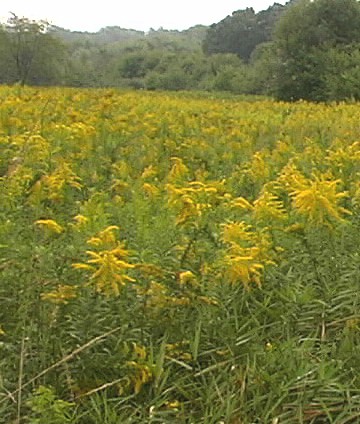
A late summer old field with abundant blooming goldenrod (primarily Solidago altissima, S. rugosa, and S. gigantea in this case)
One common misconception about goldenrods is that they cause “hay fever.” This is NOT the case. Goldenrod flowers are insect-pollinated — they attract insects that feed on the blossoms’ nectar and pollen. Goldenrod’s pollen grains stick to an insect’s body and are subsequently carried to other goldenrod blossoms, enabling cross-pollination. Because goldenrod pollen is relatively large and heavy, it is not carried by the wind. The common villain of late-summer “hay fever” allergies are ragweeds, such as annual ragweed and giant ragweed, whose inconspicuous green flowers produce large amounts of small, light-weight, wind-born pollen. The photo above shows an old field in central Pennsylvania during early September. The goldenrods there are mostly Solidago altissima, though other species such as S. gigantea and S. rugosa are present.
Goldenrods such as Solidago altissima and S. gigantea are clonal plants that spread vegetatively by specialized underground stems called rhizomes. They also disperse via sexually produced seeds. Because of vegetative growth through rhizomes, goldenrods form clumps of stems that are all genetically identical (i.e., a clone). Each individual stem within a clone is termed a ramet while the entire genetic individual is referred to as a genet. In recently abandoned fields, it is often easy to spot the individual clones. However, over time old fields may contain relatively few clones each with hundreds of ramets. Research in the Abrahamson lab examined how suitability for gall formation and preference on the gall fly’s part varies among host-plant clones.
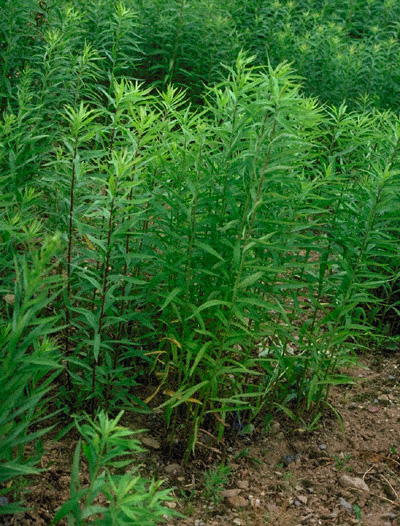
A Solidago altissima clone surrounded by other goldenrod clones
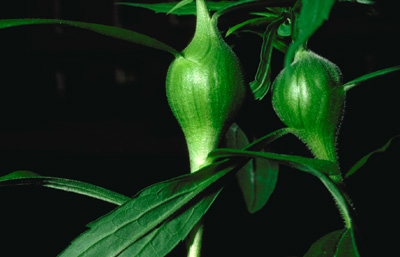
If you see a goldenrod with a ball gall in central Pennsylvania, it is almost certainly on Solidago altissima (although we have found a very few ball galls on S. canadensis and on S. rugosa). But farther north in northern New England, upstate New York, Michigan, Wisconsin, and Minnesota, ball galls are also common on S. gigantea. A fascinating line of research determined why and how this host shift has occurred. Because the ball gall fly (Eurosta solidaginis) mates on its host plant, host shifts can produce behavioral isolation between populations of host-associated ball gall flies. This isolation is very important because it may lead to new species via sympatric speciation. The host races of ball gall flies are likely the early stages of speciation.
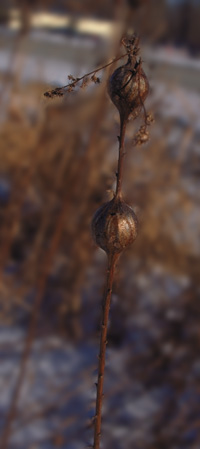
multiple ball galls
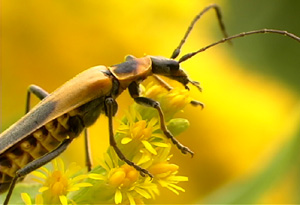
When goldenrods bloom in late summer and early autumn they provide a bonanza of food (in the form of nectar and pollen) for insects such as the goldenrod soldier beetle above. Clones of goldenrod are truly “Islands of Life.” Nectar collected from goldenrods by honeybees produces a delightful tasting honey but it’s a honey that tends to crystallize and so it is most often used in the baking trade.